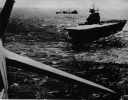Part
3: The Result
In a little more than two hours, the Japanese had sunk 21 ships and killed more than 2,000 Americans. It was a devastating blow.
When U.S. President Franklin D. Roosevelt asked Congress to declare war on Japan the day after the attack, the answer was a resounding yes. An American that had been deeply divided over how much aid to give the Allies was not united in a common purpose: make the Japanese pay for their attack and rid the world of Nazism and Fascism. Admiral Isoruku Yamamoto, who had planned the Japanese attack on Pearl Harbor, had studied at Harvard University and knew well the temperament and capabilities of the American people. He had warned others in the Japanese government that for the Pearl Harbor attack to succeed, it must be a crushing blow. The attack was devastating, yes, but it wasn't a crushing blow. Moreover, it gave the American soldiers and their families a rallying cry that carried them through to the end of the war: "Remember Pearl Harbor." First page > The Noise at Dawn > Page 1, 2, 3 |
|
Social Studies for Kids
copyright 2002–2024
David White

 However,
the American aircraft carriers were not in port. They were
out to sea. As later results would prove, the aircraft
carrier was the dominant ship in the navy. By not sinking
the American carriers, the Japanese left the American left
fleet largely intact. Of the 21 ships that were sunk on
December 7, 1941, all but three were eventually refitted and
sailed again under the American flag during the war.
However,
the American aircraft carriers were not in port. They were
out to sea. As later results would prove, the aircraft
carrier was the dominant ship in the navy. By not sinking
the American carriers, the Japanese left the American left
fleet largely intact. Of the 21 ships that were sunk on
December 7, 1941, all but three were eventually refitted and
sailed again under the American flag during the war.

